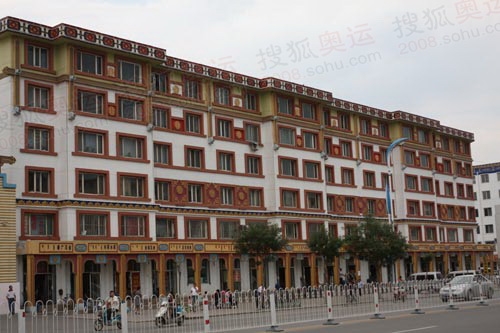Urbanizing China's Ethnic Minorities
 China's urbanization push has been in the headlines recently. Of course after 30 years, China's urbanization is not exactly fresh news. But recent reports of opposition to China's urbanization plan underscore just how integral urbanization is to the most pressing issues facing China now: 1. Maintaining economic growth through consumer spending, 2. Reducing the income disparity between urban and rural areas, 3. Growing Municipal and local government debt. One area that receives less attention is the issue of "forced urbanization" in ethnic minority regions, such as those home to Tibetan and Uighur populations.
China's urbanization push has been in the headlines recently. Of course after 30 years, China's urbanization is not exactly fresh news. But recent reports of opposition to China's urbanization plan underscore just how integral urbanization is to the most pressing issues facing China now: 1. Maintaining economic growth through consumer spending, 2. Reducing the income disparity between urban and rural areas, 3. Growing Municipal and local government debt. One area that receives less attention is the issue of "forced urbanization" in ethnic minority regions, such as those home to Tibetan and Uighur populations.
While China's efforts to forcibly relocate farmers to new cities does not target ethnic minority areas specifically, the policy has unique consequences because such populations are even less prepared for the move to urban life than their Han counterparts. In border regions of China: in Xinjiang, Qinghai, Yunnan, and Gansu provinces for example, efforts to urbanize nomadic peoples are proving difficult and controversial. Human Rights Watch estimates that 2 million Tibetans have been moved as part of similar programs in Tibet alone.
A few months ago I visited a new town on the Tibetan plateau in Qinghai province where members of the Tu minority (closely related to Mongolian peoples) are being moved to new housing. The program is part of the nationwide urbanization effort, but is also justified as part of the "new socialist countryside" program, which promised to invest more in rural communities. While the program may have good intentions, the results are often misguided at best and tragically destructive at worst.
Tongren County, or Repkong in Tibetan, is known throughout the Tibetan world as the home of a famous school of thangka painting. The paintings can fetch very large sums, and the steady stream of tourists, both Chinese and international, is a constant boon to the local economy. In many of the villages, more than half of the boys are employed as painters.
Guomari Village is one such place. It's unique earthen-walled courtyards and city walls make it one of the most intact examples of vernacular architecture in the region. The government recently developed plans to preserve it as a tourist destination. But in order to do so, a new town has been built a few miles to the north that will house residents relocated from the old town, which will see its population decline (currently 3,800) as it is refurbished to accommodate tourists and other tourism-related facilities like hotels and restaurants. It's a story that has happened in many historic towns in China: preserving the physical structures for tourism while utterly hollowing out any living culture that might have existed in the first place.
Along a barren stretch of highway to the north, a tract of bare-bones brick courtyard houses is already home to a few relocated residents. But while the government provided the basic infrastructure, they neglected to provide other components of a fully-functioning community: there are no schools, no water, and no temples or religious sites. According to the village head "all the construction workers were brought in from Hunan, therefore the quality is not good."
About 50% of villagers work outside in other cities, many in the coal mines of Inner Mongolia. But unlike peasants from areas in central China, Tibetans and Tu peoples are much less likely to end up in big cities like Shenzhen or Beijing. The language and cultural barriers make it much harder for them to adapt to factory jobs or other occupations requiring Mandarin.
The old town is built around a monastery and temple, the stupa of which is visible from around the valley below. Like many communities in the Tibetan plateau, religious traditions shape many of the routines of daily life. Townspeople get up before dawn to make rounds spinning the prayer wheels at the temple. Monks make their way to and from houses in the village. But the design for new resettlement housing does not accommodate any of these cultural practices.
While China's urbanization has been concentrated in eastern coastal cities, current plans aim to increase the pace of urbanization in western regions in order to boost GDP and living conditions. However, programs to urbanize and "settle" semi-nomadic groups are also part of China's longstanding efforts to solidify control over border regions rich in natural resources and land. Already the influx of Han settlers into Tibet and Xinjiang is making these groups increasingly marginalized, even in their own "autonomous" prefectures and counties. In Tongren, development in the county seat is expanding into the surrounding countryside, and the small city is bustling with hotels and workers pouring in from the surrounding villages to sell thangka paintings to tourists.
While tourism and development have brought economic benefits to the area, the current plans for resettling residents could destroy the very culture that draws visitors while also failing to provide for the residents' needs. But this is not unique to Tongren or Qinghai province: across China: nomadic and minority populations are being forced to become urbanized, and in the process "sinicized" as well. Relocation may be disruptive even for rural Han peoples, but for ethnic minorities, the move often means a loss of culture and identity that is tied to specific places and religious practices. China's urbanization plans, if not carefully managed, could end up fanning the flames of ethnic tension in already unstable regions.



